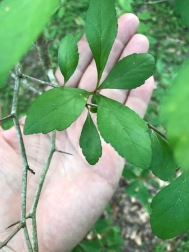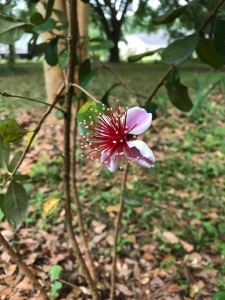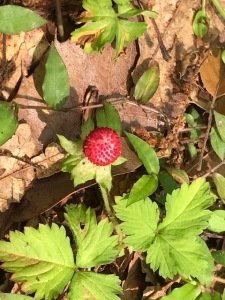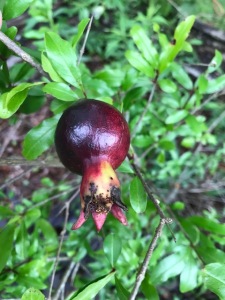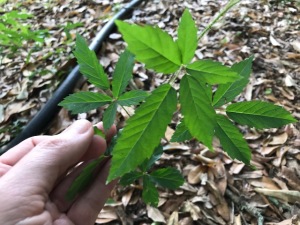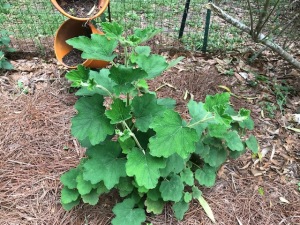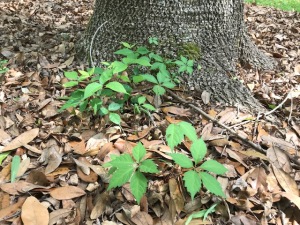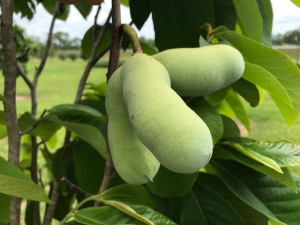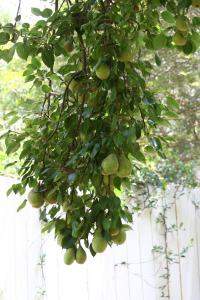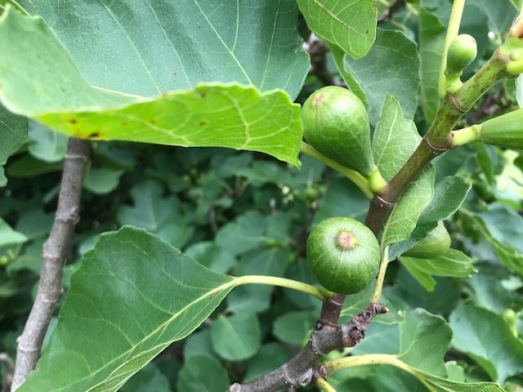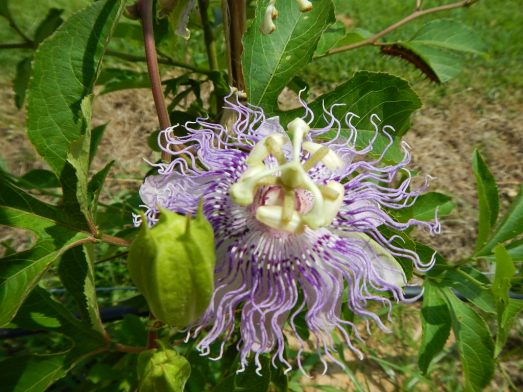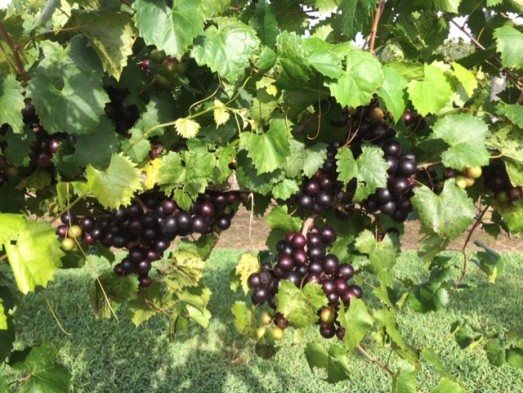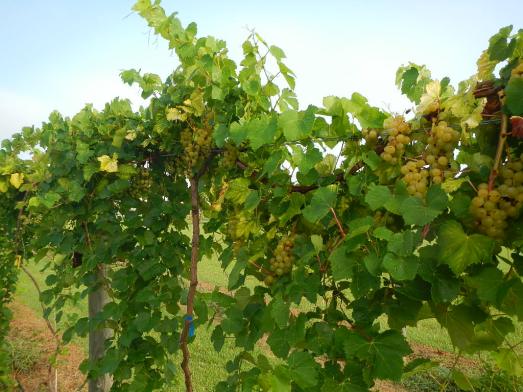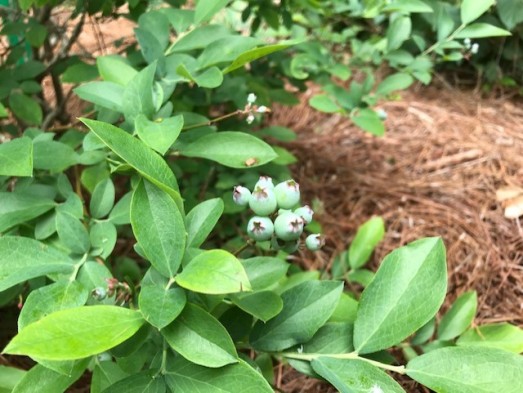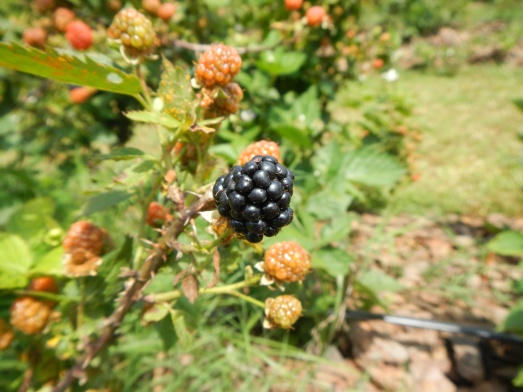The latest issue of the Mississippi Vaccinium Journal is now available in PDF form MSVJ_9_3
#YardFruits: Lesser Known Fruits
This final week of #YardFruits focuses on random fruits in my yard instead of a single fruit. Just some tidbits that don’t fit on a larger scope. Thanks for reading and I hope you learned something along the way.
Mayhaw (Crataegus) is a fruiting tree that grows native in Mississippi. You usually find it near wetland areas. The fruit is red but is not eaten raw. It is made into juice, jam, or jelly. A local company uses it in Kombucha. It has thorns, as it is in the hawthorn family.
Pineapple Guava (Feijoa sellowiana) is native to South America. It tolerates hot temperatures, but does better between 80-90 F. The mature fruit tastes of pineapple/guava/strawberry and emits a fragrant odor. It is a slow-growing shrub or tree up to 15 feet tall or so. More information can be found at this link: https://www.crfg.org/pubs/ff/feijoa.html.
False strawberry (Potentilla indica) is a species native to Asia but has become naturalized in many areas of the world. It produces an edible, tasteless, strawberry-like aggregate accessory fruit. I have heard of it being made into jam and jelly, but you’d need to pick millions of them!
Pomegranate (Punica granatum) plants don’t do especially well in hot, humid environments, although better variety selection may help. This young plant is producing flowers for the first time and it set 1 fruit. Pomegranates prefer a more Mediterranean climate. Fruit splitting/disease are problems in south Mississippi.
Southern dewberry (Rubus trivialis) grows wild in my yard producing small fruit. Since the middle (torus) is removed with the fruit it is considered a blackberry. This plant flowers early in spring, earlier than other blackberries. Growth habit is trailing and it has many prickles along stem.
Fuzzy raspberry (Rubus moluccanus var. trilobus) has origins in the Australasia region. It grows well in heat but doesn’t fruit much. The fruit produced is crumbly and isn’t especially tasty. But, it could be used more in breeding (IMO) because of its exceptional heat tolerance.
Poison ivy (Toxicodendron radicans) and Virginia creeper (Parthenocissus quinquefolia) are both weed species, yet they have edible fruit-bearing relatives. Virginia creeper is in the grape family Vitaceae. Poison ivy is in Anacardiaceae which includes mangoes, pistachios, and cashews.
Bonus! I wish I had Pawpaw (Asimina triloba) in my yard but I don’t (yet). This small tree has the largest native edible fruit in North America. In the Annonaceae family, it is related to tropical fruits like cherimoya, sweetsop, and soursop. An understory tree, it grows very well in shade (but produces more fruit in sun). This photo is from the MSU Horticultural Unit in Beaumont, MS.
#YardFruits: Pears
This is the penultimate #YardFruits thread and in this week’s edition I cover the mighty, hardy pear tree. They grow so well in so many different environments. Can’t grow an apple? Try a pear instead!
Pear trees are in the Rosaceae family – one of the most important crop families if one takes into account economic importance. The most commonly grown pear species is Pyrus communis but there are many other species including P. pyrifolia, the Asian pear.
We grow both of these kinds in Mississippi. While we do produce some apples they are far more difficult to grow due to disease. Pears can be grown with little care, but produce much better fruit with control of diseases and insects (like stink bugs).
One serious disease that pears get is fire blight (Erwinia amylovora). Fire blight is a bacterial disease, so fungicide sprays will not control it. Affected areas can be cut out, also preventative antibacterial and copper-based sprays help. However, the best option is to plant resistant/tolerant varieties.
Cedar-apple rust (Gymnosporangium juniperi-virginianae) has two hosts, cedar (juniper) and apple (also pear). Genetically resistant/tolerant varieties should be grown, but fungicides can help if used properly. Removal of the alternate host is usually impractical due to the great distance necessary to accomplish control (miles!). Sanitation is encouraged to help reduce inoculum of this disease as well as other diseases.
Pear fruit is climacteric, meaning that the fruit is responsive to ethylene while ripening. European-type pears ripen from the inside out and should be harvested prior to full ripeness. Storing them in a cool place for a couple days should allow them to fully ripen, especially when stored with other fruits that release ethylene like apples and bananas. Asian pears can ripen on the tree.
Some find the flesh of pears to be “gritty”. This “grit” is from stone cells, also called sclereids. Some research has suggested pears may have more of these stone cells in response to stress. Apples and Asian pears do not have these cells and thus have a “smoother” flesh.
Pear trees are grafted on a rootstock when bought from a nursery. A semi-dwarfing rootstock is best, otherwise trees can get very tall making them difficult to manage. Training to a central leader when the tree is young will also make later management easier by reducing poor crotch angles and excess intra-canopy competition.
Pruning is an annual activity on pears, especially when they are younger and growing quickly. Remove downward growing, crossing, and broken and diseased branches. Also remove those branches with poor crotch angles. Make larger cuts in the dormant season and don’t cut past the branch collar as this can lead to trunk damage.
Improper pruning can cause long term problems for the pear tree. Poor pruning technique can lead to overcropping, slow wound “healing”, and added tree stress. Cuts that do not “heal” quickly are susceptible to insect and disease pests.
#YardFruits: Figs
It is week 8 of #YardFruits and in this edition I will talk about a favorite fruit of folks in the South — #Figs. There are so many planted in back yards in Mississippi, but they are not always without problems. Yet, they can be prodigious producers as well.
Interestingly, figs belong in the mulberry family, Moraceae. Relatives include mulberry, osage orange, weeping fig, and jackfruit. Hops and Cannabis sativa (commonly known as marijuana, mary jane, pot, grass, or weed) were once in the family but since changed.
Ficus carica is the species of common fig. Common figs do not require pollination (parthenocarpic) for the figs to develop, and they contain no seeds and have no grit. Other types of figs include caprifig, New Smyrna, and San Pedro.
Popular varieties in Mississippi include Brown Turkey, Celeste, and several from the LSU breeding program: LSU Gold, LSU Purple, and several others. Hardy Chicago is one that is somewhat cold hardier for areas that have colder winters.
The fig is really a flower stem that is sort of turned inside out so the many little flowers are on the inside. The fleshy outside is stem tissue. It can be eaten raw, dried, or processed into jams.
In Mississippi, we often see two different crops a year. The first is called a breba crop which develops in the spring from the previous year’s growth. This is usually a smaller crop. The main crop is produced later in the summer and early fall.
The fruit is popular with all kinds of animals and birds so it may be necessary to protect the figs with bird netting or other protective measures to ensure a harvest. Even Squatch likes them (check my Twitter thread for context on this)!
The failure of plants to produce figs and carry them through to edible maturity can be attributed to planting the wrong variety, fig rust, nematodes, freezing back to the ground, cold-damaged growth, and a lack of soil moisture.
Figs respond to a lack of soil moisture by shedding leaves, dropping immature fruit, and failing to ripen fruit. One inch of water per week during the growing season is adequate. A layer of organic mulch several inches deep under the fig bushes conserves soil moisture and reduces weeds.
Fig plants can be trained to either tree or bush form. In Mississippi, fig plants are often frozen back to the ground by winter cold, making the tree form impractical. The plants prefer a well-drained soil and a Mediterranean climate but are adaptable to other climates as well.
#YardFruits: Passion Fruit
It’s week 7 of #YardFruits and this time I’m going to throw out a curveball – a usually tropical fruit that has some temperate climate cousins. Passion Fruit is the name and beautiful deliciousness is its game. There is still so much to learn, but here is some of what I know.
The most common species of edible passion fruit is Passiflora edulis. This species comes in two forms: Passiflora edulis f. edulis (purple fruit color) and Passiflora edulis f. flavicarpa (yellow fruit color). The purple passion fruit has sweeter fruit, but it is more prone to diseases.
While not extremely common, these tropical species are grown in the U.S., especially in Florida and Hawaii. They are not especially cold hardy plants and will not reliably overwinter outside of zone 10. I’ve had them die back to the ground and come back but they are never quite the same.
In subtropical and temperate zones there are other species that perform better. One of these is Passiflora caerulea, the blue passion flower. It also can produce fruit, but it is said to be insipid and not tasty. However, it can grow and produce many spectacular flowers.
Throughout much of the eastern U.S. grows an edible species, Passiflora incarnata. The common name for this species is Maypop. The fruit can be quite large, but since it is wild the flavors are variable. The flowers have both male and female parts but are self-incompatible.
Maypops are pollinated by large-bodied bee species, primarily carpenter bee (Xylocopa sp.), and also possibly bumblebee (Bombus sp.). Honeybees (Apis sp.) are too small to move pollen from anther to stigma. No self-compatible maypops have been identified, so pollen from another individual is needed for successful fruit production.
There are no named varieties of maypop and little research has been done to identify improved wild vines. I have some from Oklahoma, Mississippi, Illinois, Louisiana, and Missouri. Last year I did crosses among them and found that there seemed to be preferences. Missouri and Illinois were the best at producing fruit.
Maypops die back to ground every year when it gets cold enough (although other factors may have a role too). The vine is herbaceous unlike P. edulis that can get woody. Larvae of the Gulf fritillary butterfly love to eat the leaves and other parts. It can be a pest.
I’ve made crosses among P. edulis f. flavicarpa, P. incarnata, P. edulis f. edulis, and P. caerulea. The problem is compatibility and sterility in the progeny. For flower production that is not a big deal, but fruit? Oh yeah. Other species will be tried in the future.
What to do with the fruit? It can be eaten fresh or juiced. The seeds of P. edulis are edible, but not maypops (too large and hard). One year I pressed maypop fruit and made a cocktail syrup. It turned out surprisingly well. Give it a chance, you might be surprised and delighted.
#YardFruits: Muscadines
Welcome to week 6 of #YardFruits. Last week I regaled you with information about bunch grapes. This time I will cover a related crop – Muscadines. These are native throughout the southeastern U.S. Some say it is a niche crop. Actually, I say that too.
Muscadines are related to bunch grapes, both in the Vitaceae family. While bunch grapes are in the Euvitis subgenus, muscadines are in Muscadinia subgenus of which there are only 3 species: Vitis rotundifolia, V. popenoei, and V. munsoniana (there is some dispute among taxonomists in all of this).
Sometimes folks call all bronze-skinned muscadines “scuppernongs” (or some variation of that). In fact, ‘Scuppernong’ was the very first muscadine variety. It was found along the Scuppernong river in North Carolina. Muscadines also come in black, purple, red or some gradient thereof.
Muscadine vines grow wild around the perimeter of my yard, although most of them bear no fruit. It has been estimated that 65-75% of all vines in the wild are male and do not produce any fruit at all. So if you find one with fruit, it is somewhat uncommon.
Varieties of muscadines fall into either female vines or self-fertile vines. If you want to grow a female vine, then a self-fertile vine must be planted near it for pollination. Why plant a female vine? Often the fruit are larger and the overall yields can be higher.
I grow a self-fertile variety called Southern Home. It has excellent ornamental qualities from its unique leaf shape and the fruit is very good. Yields are often low, but I’m not concerned with that for my home use. I’ve also heard it makes good wine. Southern Home is an interspecific hybrid with V. vinifera in the background.
Since muscadines are from the southeastern U.S. they have a low chilling requirement for most varieties. Work at the University of Arkansas to breed for more northern adaptation is ongoing but results are still in the future. Muscadines break bud late in the spring (compared to other fruit crops) so they are not often damaged by frost and freezes.
Muscadine vines grow vigorously, so they need more room than bunch grapes. We plant them 15-20 feet apart in a row and 12 feet between rows. They do not need a lot of N fertilizer each year (but some will replenish lost nutrients) and they can benefit from irrigation. They must be pruned annually in the dormant season, usually they are spur pruned.
In Mississippi, muscadines grow very well. They are resistant or highly tolerant of Pierce’s disease and many fungal diseases. They often are grown without sprays of any kind (although they benefit from some pest control). Bees and wasps are a huge nuisance though around harvest time.
The fruit does not grow in large clusters like bunch grapes but just a few large berries. These berries fall off the vine when ripe, although some varieties hold them long enough to harvest. Every year, Mississippi State University Extension hosts a Muscadine Field Day (although probably not in 2020) where attendees can taste many varieties.
#YardFruits: Grapes
Welcome to week 5 of the #YardFruits thread where I talk about fruiting plants in my yard. This time I give out some nuggets of info on bunch #grapes (Euvitis) ((but not muscadines (Muscadinia) – that is another topic to be covered later)).
Grapes are an ancient crop dating back thousands of years. Grapes as food and wine are important to the history of man. While we still grow old varieties, there have been substantial improvements made via breeding that allowed more people to grow and enjoy this crop, such as seedless grapes.
I grow an obscure variety called MidSouth. It was released from Mississippi State University in the early 1980s. The vine is resistant to Pierce’s disease (PD), the primary limiting disease for growing grapes in much of the South. MidSouth is an interspecific hybrid, unlike Vitis vinifera grapes such as ‘Chardonnay’, ‘Merlot’, ‘Cabernet Sauvignon’, and many others.
We can only grow varieties resistant to PD. The best is probably ‘Blanc Du Bois’, a University of Florida release. It is vigorous and productive but also gets anthracnose something terrible. I have in my research plots but I don’t like it – too much work. Others include ‘Black Spanish’, ‘Champanel’, ‘Lake Emerald’, among several more.
Growing grapes in your yard is a often a struggle, especially in the South so usually I recommend muscadines instead. Mississippi has only few wineries so demand for fruit is small. However, new releases from Dr. Walker at the University of California-Davis may have utility. I’m testing them and they have not done well for me in south Mississippi, but the are still young.
In south Mississippi, bunch grapes are rarely grown. Our climate is difficult because of rain (we average more than 1 inch per week for the entire year = 60+ inches) and humidity (near the Gulf of Mexico). Fungal diseases are rampant here, as well as PD. There are also insects to deal with. Many can be controlled with spray programs, but willingness to spray is economic and cultural decision.
Grapes have many pests, which is why I use the guide from smallfruits.org (https://smallfruits.org/files/2020/02/2020-Bunch-Grape-Spray-Guide.pdf ). It is best to start early in the growing season to control fungal diseases. Insects should be controlled when identified by scouting (with a few exceptions such as grape phylloxera).
The grapevines I have in my yard are not very old so they have not produced fruit yet. They often have leaf damage from grape flea beetles, as this is a common pest in our area. There are several wild vines around my property too that also attract this, and other pests.
Vines can grow very fast. I’ve trained them in 1 year and had a crop in year 2. Weed control around vines is critically important to establish vines. They don’t need much N fertilizer, 50 lbs/N/acre/yr is a place to start. Irrigation is beneficial when vines are young and also mature vines carrying a crop load.
Grape vines get to full production by year 5. Yields of 20-40+ lbs per vine not uncommon. I use a single high wire bilateral cordon training system. A wire is at 6 feet off the ground. Vine spacing is 6-8 feet between vines and 10-12 feet between rows. Pruning is an annual activity done during the dormant season. I do spur pruning, but cane pruning is done in some areas on some varieties.
#YardFruits: Blueberries
I’m back again this week with another thread on my #YardFruits. This plant is now a commercial plant grown all over the world, but it wasn’t until the early 1900s when it was domesticated – the blueberry!
Vaccinium corymbosum, the highbush blueberry, is the most popular blueberry around the world. It was first domesticated in Whitesbog, New Jersey, a place I got to visit a few years ago. Elizabeth White and Frederick Coville collaborated to introduce the first variety ‘Rubel’.
A more recent development is southern highbush blueberry. Some regions were too warm for highbush and too cold for rabbiteye so there was a need to bridge the gap. Dr. Sharpe from the University of Florida used a diploid V. darrowi selection, Florida 4b. An interesting history of that selection and its place in blueberry breeding can be found here: https://www.pubhort.org/aps/57/v57_n4_a22.htm
There are many species within the Vaccinium family. Several grow wild in or around my yard, including V. elliottii, V. arboreum, V. virgatum, and probably others I haven’t yet identified. Vaccinium virgatum (aka V. ashei) is the rabbiteye blueberry and is the most widely grown in Mississippi.
Rabbiteye blueberries require cross pollination, so 2 different varieties with overlapping flower times are needed. These plants flower and fruit later than the highbush varieties, so frost damage is rarer for us in south Mississippi, but some years it is a problem.
They require about 50+ lbs N/acre/year, although that can vary depending on site. Irrigation is a must in commercial settings but for homeowners it is usually not necessary in Mississippi. Rabbiteye blueberries are very vigor plants and are well-adapted to our environment, so they take the heat well.
Blueberries are typically mulched with an acidic organic mulch like pine bark or pine straw. Blueberries prefer a soil pH between 4.5-5.5. Rabbiteye blueberries can tolerate a little higher than that but highbush not as much. Outside of this soil pH range causes plant decline and nutrient deficiencies.
We prune blueberries differently in south Mississippi (also done in other areas around the South). Shear the bushes back immediately after harvest to about 1 ft shorter than ideal size and allow the bush to regrow during the summer. Next year’s fruit will come from this new growth. This type of shearing is not done later than August 1. Old, broken, and diseased canes can be removed during winter.
Yields in Mississippi range from 4000-10,000 lbs/acre but can reach higher. Berries should be harvested when fully blue. Harvest of southern highbush usually starts in late April in Mississippi and rabbiteye starts in mid-May and goes into July. Once harvested, get fruits cooled quickly for best quality and shelf life.
Our blueberries in south Mississippi have relatively few pests when compared to peach or apple, but there are some. I often have damage from blueberry gall midge, mummy berry, and stink bugs. Exobasidium is another fungal disease that has cropped up in recent year, although I don’t have that issue in my yard. Spotted-wing drosophila is a problem in commercial production, especially in the later fruiting varieties, but for homeowners it is not typically a big issue.
Mississippi Vaccinium Journal April-June 2020
Please see this link to access the Mississippi Vaccinium Journal (aka blueberry newsletter)
This is the coronavirus edition. Let me know if you need anything!
#YardFruits: Blackberries
I’m back again for the third installment of #YardFruits. This week is a plant grown all over the world that is only a relatively recent commercial crop – the blackberry!
Blackberries (Rubus subgenus Rubus) are a group of several species. It depends where you live what species were used in breeding. Eastern U.S. started mainly from R. allegheniensis, R. argutus, and R. frondosus whereas the Western U.S. was R. ursinus and a couple other species.
Plant architecture can be different among cultivars – erect vs. trailing (with middle variations). Erect types can be grown without a trellis, but trailing must have one. Both would benefit from having a trellis system.
For a long time only thorny types were available but many thornless cultivars are now on the market. The University of Arkansas breeding program has many thornless cultivars including Ouachita, Natchez, Caddo, and Ponca.
Only 1 cultivar needed for pollination, because the plants are self-fertile. Production starts in year 2 and peak is by year 5. Lifespan is about 8-10 years. Fertilizer needs are generally low, ~ 50 lbs N per acre per year, but could be higher in some soils and locations. Irrigation is beneficial, as is mulching. Prune out spent canes after harvest or in fall/winter.
The primocane-fruiting trait, common in red raspberry, is a recent novel discovery in blackberry. It was exciting to be in graduate school at the University of Arkansas when the first selections were made. First releases were ‘Prime-Jim’ and ‘Prime-Jan’ named after breeder Dr. Jim Moore and his wife Jan.
In the South, primocane fruiting is problematic because of the heat. This leads to poor yields and quality on the fall crop. Spring crop is still fine. Heat causes a lot of problems on the flower and fruit, contributing to such conditions as white drupelet disorder.
Blackberries are a relatively easy crop to grow because of their adaptability to many types of soils and climates. But they are not pest free plants. In fact, weed control is a significant factor in being able grow them successfully. So using mulches, either organic or weed barrier material can help with this. Otherwise it will be a real challenge to keep weeds from taking over, especially when the blackberry plants are small.
Disease do attack blackberries. In Mississippi, double blossom (rosette) is a fungus that attacks buds making them look unusual and not set fruit. Other diseases include anthracnose, botrytis, and rusts. These can usually be controlled with fungicides.
Insects are difficult pests for blackberries. The number one right now is spotted-wing drosophila fruit fly. It attacks fruit when it starts to color, laying eggs which results in worms in the fruit. The consequences are small for a homeowner, but for commercial growers a big problem.

